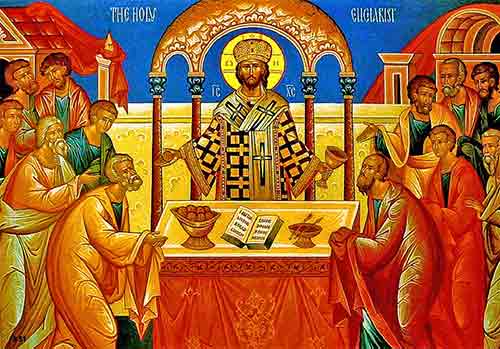
This post follows my reflection on
- the Eucharistic Prayer starting page 420 in A New Zealand Prayer Book He Karakia Mihinare o Aotearoa (NZPB/HKMA)
- the Eucharistic Prayer starting page 436
- the Eucharistic Prayer starting page 467
- the Eucharistic Prayer starting page 485
and their revisions. - the Eucharistic Prayer starting page 512 (a framework for producing your own)
In reflecting on the quality of a Eucharistic Prayer (a Great Thanksgiving), here are some of the things I’m looking out for:
- Clearly a prayer of thanksgiving – consecrating by the community giving thanks (led by the gathered community’s presider) for the great acts of God
- following the Jewish Berakah structure (Praise – Proclaim – Petition – Praise)
- Easily-remembered, consistent responses and acclamations (so preferably poetic and singable) for the gathered community so that they are not focusing on a book (or a projector screen)
- Inclusive and expansive language
- A prayer that flows well, keeps to a consistent tone, and has a broad enough theology to cover acceptable interpretations
Let’s look at another Eucharistic Prayer authorised or allowed in the Anglican Church in Aotearoa, New Zealand and Polynesia.
Alternative Great Thanksgiving E
This is presented as “An alternative to A Form for Ordering the Eucharist on page 512.” But the whole point of the particular Eucharistic Prayer in that Form for Ordering the Eucharist is that it enables the production of individual Eucharistic Prayers! So the first thing you notice with Alternative Great Thanksgiving E is that it is NOT a framework for producing an individual prayer. In fact, unlike every Eucharistic Prayer looked at so far, there is no choice whatsoever [Not 100% true: you can choose between 2 acclamations after the Last Supper story!]
It has already been noted on this site, that the original makes no reference to sin. We were told, “The presiding priest now gives thanks for the salvation of the world through Christ“, but “The following… words” did not explain what the salvation involved. In the original, you could insert that as “other suitable words“.
In the Last Supper story of the original, sin was also conspicuous by its absence. BUT – even though normally in the Last Supper story within a Eucharistic Prayer (the words “for the forgiveness of sins” are usually present there); only in Matthew’s account (of the four, Mt, Mk, Lk, 1 Cor) is there this explicit mention of sin.
Basically, this “alternative” is the original with the flexibility removed, and a couple of alterations.
The physical Prayer Book original has “fulness” – following the British, non-USA spelling. The alternative changes this to “fullness” – we are becoming more Americanised!
Looking (beyond agreed responses and acclamations) at the gendered words of ‘Father’, ‘Lord’, and ‘Son’, the word ‘Son’ is used three times – in each case alternatives could have improved the prayer.
The original prayer’s
Unite us in Christ
and give us your peace.The presiding priest may add further prayer that all may receive the benefits of Christ’s work and renewal in the Spirit.
The prayer ends with these or similar words.
All this we ask through your Son
Jesus Christ our Lord,
to whom with you and the Holy Spirit
be all honour and glory,
now and for ever. Amen.
has become
United in Christ,
through the power of the Holy Spirit,
we raise to you, O God, our songs of everlasting praise.Blessing, honour and glory be yours,
here and everywhere,
now and forever. Amen.
This Alternative prayer continues the problematic “Strengthen us… to be your [God’s] body in the world.”
And all suggestions of
The presiding priest gives thanks to God for the work of creation and God’s self revelation.
The particular occasion being celebrated may also be recalled.
The following or any other suitable words are used.
…
The presiding priest now gives thanks for the salvation of the world through Christ.
The following or any other suitable words are used.
…The presiding priest may add further prayer that all may receive the benefits of Christ’s work and renewal in the Spirit.
The prayer ends with these or similar words.
have been removed.
This prayer, like the other “Alternative Great Thanksgivings“, was rushed through authorisation, as I have explained, once the Church acknowledged that it had not been licit in the way it had gone about authorising experimentally. With more time, I think this would have become, could have become, a much better prayer.
As it stands, I don’t see how this Alternative adds anything of consequence to the plethora of options available to NZ Anglicanism – it was substantially allowed already by the framework for which it is the “alternative”.


